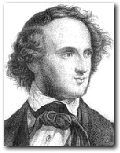 Felix Mendelssohn
Felix Mendelssohn
Click the above graphic to hear Mendelssohn’s ‘Overture’ to A Midsummer Night’s Dream
|
The Mendelssohns were highly cultured folks, and young Felix was no exception. His Overture Op. 21, written when he was 17, sums up his feelings about Shakespeare’s A Midsummer Night’s Dream, which was a family favorite. The remainder of the work (Op. 61), meant as incidental music for the play, was written some 16 years later.
The Overture opens with shimmering strings that evoke the atmosphere of a fairy world. A ceremonious theme depicts the Theseus’ court, and the young lovers are portrayed by a singing tune. The "rude mechanicals" are introduced with a clumsy, clumping tune; this is followed by Nick Bottom’s transformation into a donkey. The piece is concluded by a melting fairylike coda.
|
|
Opus 61 comprises 13 pieces, the first of which is a Scherzo depicting the darting movements of Puck and the fairies in Act 2. No. 2 is a march announcing the arrival Oberon and Titania, complete with fanfares.
The Intermezzo (No. 5) depicts Hermia awakening from her dream to find her beloved Lysander gone. She goes anxiously searching for him, nervous darting phrases in the music show her fretting.
Then of course there is the very famous No. 9. Haven’t heard of it? You must have heard it before, it’s none other than the Wedding March. And the three couples lived happily ever after.
Listen to the fairylike Overture (Op. 21) and the very famous Wedding March (Op. 61, No. 9).
|
Recommended recording:
|

|
Mendelssohn - Midsummer Night’s Dream:
A wonderful recording of this piece by the London Symphony under André Previn, masterfully digitized from LP to CD. Not to be missed.
|
|